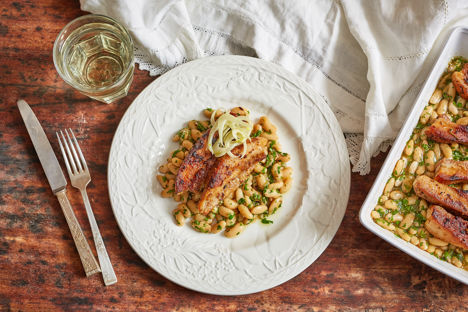
The ultimate wine pairing menu
Want to experience just how well specific wines can complement specific dishes? Try cooking our four-course menu complete with wine pairing suggestions to see how the right combinations can result in truly astounding flavours.
The ultimate wine pairing menu
Want to experience just how well specific wines can complement specific dishes? Try cooking our four-course menu complete with wine pairing suggestions to see how the right combinations can result in truly astounding flavours.
Fine dining restaurants put a huge emphasis on their wine selections, with sommeliers undergoing years of training in a bid to match the perfect bottle to a particular dish on the menu. That can make food and wine pairing seem a little intimidating, but it’s actually very simple to do at home with a little know-how and research. Most of us know the general guidelines of pairing fish with white wines and red meat with red wines (although there are many exceptions to these rules), but it’s only when you start delving into specific wine varieties and really thinking about how they’d work with what’s on the plate that you start discovering combinations that improve the flavour of both the wine and the food.
The four recipes below developed by The Kitchen with Great British Chefs would make a wonderful dinner party menu on their own; once paired with our wine suggestions, however, they become something even greater. While it might sound pretty excessive to open four different bottles of wine for just one meal, systems such as Coravin allow you to enjoy the contents without any leftover wine going to waste (for more information on how it works, see our feature). Take a look at what we’ve picked and why the pairings work together.
Canapé
Creamy on the inside, crunchy on the outside, these autumnal croquettes are the perfect little bite to kick off any dinner party. The combination of potato, celeriac and cheese – bound together with plenty of milk and butter – means an oaked Chardonnay makes a wonderful wine to serve alongside. Because it has been aged in oak it has a more complex, richer and fuller flavour, often with notes of vanilla and caramel instead of crisp fruits. Many describe the flavour as buttery, which is why it works with these indulgent croquettes, but there’s enough green and grassy flavours still present to work with the fresh flavours of the celeriac.
Chardonnay is produced all over the world, but bottles from the US are almost always aged in oak and are renowned for the buttery, creamy flavours that makes it such a popular wine.
Starter
This is a vibrant, striking and flavour-packed starter that combines the fresh, peppery flavour of watercress with an oozing egg, crunchy potato and rich black pudding. The soup can be made in advance and reheated before serving, as can the rosti, making it pretty fuss-free to boot.
With a dish that straddles both fresh and indulgent flavours, choosing the right wine can sometimes be tough. A young French Sauvignon Blanc, however, does the job exceedingly well. Crisp, bright, acidic and full of fresh green and vegetal flavours (without the overtly tropical flavours of New World-grown grapes), Sauvignon Blanc complements the watercress perfectly, remaining light enough so as to not clash with the wobbly, rich texture of the egg. While black pudding would normally mean reaching for a red wine, because it’s only a small part of the overall dish the white actually cuts through the fat quite nicely.
Main
Pork is a meat which can match with both white and red wines, but try this dish with a light red Valpolicella from Italy. Because it is light in tannins and renowned for its soft, smooth flavour, it works very well with this dish of contrasting fattiness (from the pork) and tang (from the salsa verde). Bursting with acidic cherry-like flavour, it cuts through the pork belly wonderfully but doesn’t overpower the flavours on the plate (which a richer, more tannin-heavy red would).
Dessert
Desserts are, obviously, well-suited to enjoying with dessert wines, but with something as sweet and rich as a cheesecake, it’s nice to drink something that doesn’t have the syrupy, almost sickly characteristics of sweet wines. Instead, try a rosé – sweet enough to complement the fruit but still crisp and refreshing, to cut through the creaminess of the cake. The Spanish make some of the finest rosé (or rosado) in the world, combining fruit-forward flavours with light, easy-drinking characteristics, making a bottle one of our favourite things to drink alongside a fruity, indulgent dessert.


